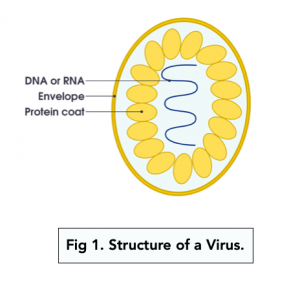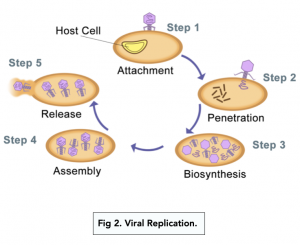Life Cycle and Replication of Viruses (A-level Biology)
Life Cycle and Replication of Viruses
Viral Life Cycle and Replication
Viruses do not undergo cell division. Instead, they infect a host cell, and use the host cell to replicate themselves and to produce new viral particles. Thus, the virus’s life cycle depends on its ability to successfully infect a host cell so that it may reproduce.

- Virus binds to host cells. Virus binds to a host cell using its attachment proteins. Viruses can have different attachment proteins, which means that different viruses infect different types of cells. The HIV virus, for example, has attachment proteins which bind to receptors on the surface of human T-cells.
- Injection of nucleic acids. When viruses infect infect a host cell, they inject their nucleic acids into the host cell. Remember that viruses can have either DNA based or RNA based genomes. Once the attachment proteins of a virus attach to a host cell, the virus latches on to the cell and injects the host cell with its nucleic acids (either DNA or RNA). This part of the viral life cycle is called the lysogenic cycle.
- Injection of unique viral proteins. Certain viruses can also inject unique viral proteins into the host cell. These viral proteins help hijack the host cells machinery in order to replicate the viral genomes and to make new viral proteins. In this process, viruses can force the cell to give up using energy to make proteins and replicate DNA for the cell, and instead focus all its energy into replicating the viral genome and making viral proteins. Obviously, this is not good for the cells.
- Release from host cell. Once the host cell has produced a sizeable number of viral particles, the viral particles will burst through the cell through a process called lytic release. Once they burst through the cell, the viruses will go on to infect other host cells.
- The host cell dies. Meanwhile, the original host cell is now dead because of a gaping hole in its cell membrane. This part of the reproduction cycle is called the lytic cycle.

Latency
- Viruses can become latent during the lysogenic part of the viral reproduction cycle. A virus can become dormant (i.e. latent) within its host cell after the initial infection. This means that the virus has stopped reproducing viral particles.
- The virus can become reactivated. At some point in the future, the virus may become reactivated. This may be due to various factors e.g. stress. The virus will resume producing viral particles, and will continue onto the lytic cycle. This means that the host may become ill without having been reinfected by a new virus from the external environment.
A virus is a tiny infectious agent that cannot reproduce on its own and requires a host cell to replicate and spread.
The life cycle of a virus typically consists of five stages: attachment, penetration, replication, assembly, and release. During attachment, the virus binds to the host cell’s surface. Penetration involves the virus entering the host cell. Replication occurs when the virus’s genetic material is copied within the host cell. Assembly involves the construction of new virus particles. Release occurs when the new virus particles leave the host cell and infect other cells.
The replication process of viruses occurs within the host cell and involves the virus’s genetic material (DNA or RNA) taking control of the host cell’s metabolic processes to produce more virus particles. This process can lead to the destruction of the host cell.
Viruses infect cells by attaching to specific receptors on the cell’s surface. The virus then enters the cell and releases its genetic material, which takes control of the host cell’s metabolic processes and forces the cell to produce more virus particles.
The main difference between DNA and RNA viruses is the type of genetic material they contain. DNA viruses have DNA as their genetic material, while RNA viruses have RNA as their genetic material. This difference affects the replication process of viruses and their ability to cause disease.
Viruses cause diseases by infecting host cells and taking control of the cell’s metabolic processes to produce more virus particles. This process can lead to the destruction of the host cell, which can cause symptoms such as fever, fatigue, and muscle aches. In severe cases, viruses can cause serious diseases such as AIDS, Ebola, and COVID-19.






Still got a question? Leave a comment
Leave a comment